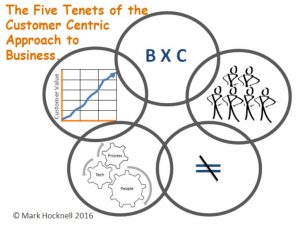
The customer centric approach to business has been proven to produce more resilient businesses (see Ranjay Gulati, Harvard Business School). This “outside in” approach to business is supported by research from Forrester. And we know that Net Promoter Score is a firm predictor of business success and sustainability, due to the fact that if you have more promoters (and positive word-of-mouth) than the alternatives available to your chosen customers, you are more likely to succeed.
Yet businesses still want to use models and structures designed for the last century – either inspired by military leadership models or post-industrial management thinking.
Customer Centricity is not a bolt-on for the business. Taking post-industrial management thinking and adding a touch of customer stuff will not produce the long-term results we all seek. The business needs to be designed in a way that leverages the customer centric principles.
This post identifies and discusses the Five Tenets of the Customer Centric Approach to Business. They are the tenets of the customer centric approach to business, because all good belief and thinking systems must have a sound set of core ideas that are at the foundation.
Tenet 1. Businesses Exist for Customers
Businesses want to be customer centric because they somewhat perceive there are benefits. In reality customers are the revenue streams for the business, not the products or services the business offers. You can have all the products and services you want, but without a customer there is no business, just an entrepreneur with a diminishing bank account, who believes in the myth ‘build it and they will come’.
Businesses exist for customers. No customers, no business. No people to serve, no organisation (even government services, non, or not-for profits). Many businesses and organisations today are too focused on themselves, internal trading and dealings, negotiations and business politics, that make the game seem like it is all about them, rather than their customers.
Tenet 2. It’s all about People
Businesses and organisations get obsessed with their to-do-lists, and the multitude of ideas that come from the planning events, developing new products, implementing new systems and so on…action orientation, important things to do.
And yet when these initiatives are in place, they are brought to life by…people. And when they don’t seem to return the benefits the leaders imagined, then…it’s about the people. “We will need to retrain everyone again”, “the change management stuff didn’t work”, “the problem wasn’t the project it’s the culture”…
Your customer contact people – sales, service or anyone who is serving/supporting someone who is in contact with a customer, including the CEO – will do better when they recognise that they are in fact humans interacting with other humans. People connecting with other people. And within these interactions, we humans rage with emotions, memories and illusions of cognition.
The revenue streams of the business are your customers, your customers paying for what they value from you. People connecting with the value you deliver. And people connecting with the people within your business. All this, however, is often forgotten among the high level of busy-ness.
If people love to work at your place, they will be productive and deliver good experiences for the customer. If people also love what you offer, you get the double-whammy and will have a successful business.
Tenet 3. Not all Customers are Equal
This reality is not as openly discussed as it should be. It almost seems to be a taboo subject for people that propose customer centricity, however it is in fact one of the core drivers of becoming a customer centric business.
All businesses have a portfolio of customers. The profitability and/or value from these customers determines the sustainability of the business.
Not all customers are equal. In the way they respond to the value you provide, nor in the way they reciprocate value back to you. Value here is the combination of fees for service/product, plus their level of advocacy (is it negative word-of-mouth, or positive word-of-mouth). So why do we randomly grow our customer portfolios with anyone that will buy from us? Likewise when we provide service or communicate with customers, why do we treat them all the same…why do we typically treat each customer as average..?
Tenet 4. Businesses are Systems that Deliver Value
Everything within the business – the systems, people, functions, processes, products and services – all work as a collective that delivers value. This overall, collective value is perceived by the customer. This perception of value is the predictor of future customer behaviour. The collective future behaviour of customers is a significant predictor of the business results that will be achieved. Based on this, the business will, over time, either thrive, survive or go into decline.
Systems Thinking is at the core of this Tenet – the collective output of the business is the delivery of value for the customer (good, bad, ugly or indifferent). From this delivery of value, come the results of the business, and then the outcomes desired by the Board, Owners and Shareholders.
Tenet 5. The Need for Progressive Improvement
There hardly seems a need to discuss the reality that businesses need to continually improve. We can see this clearly in the enormous acceptance of continuous improvement and other popular approaches that aim to reduce waste, defects, errors and achieve bankable improvements. However, continuous improvement has almost become a meaningless phrase, one of those management norms that has lost the power behind its origins. Too much focus on cost reduction rather than value and experience improvement.
The need for progressive improvement is demanded by the increasing expectations of your customers and the changing landscape of rivals seeking the attention of your customers.
Using these tenets to drive how the business is designed and structured will support business resilience and success.
There are nine imperatives from these tenets that will be covered in another post.



